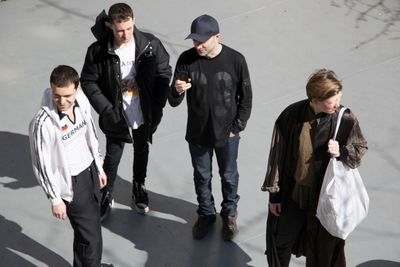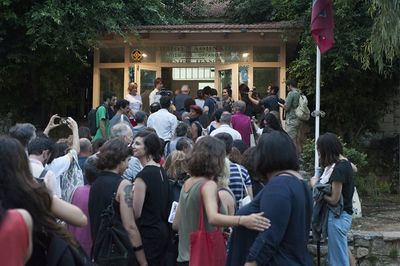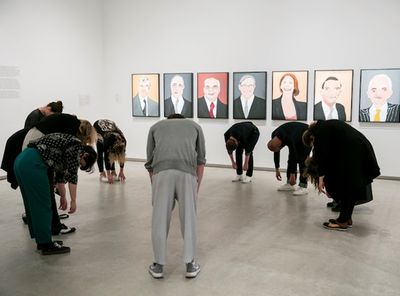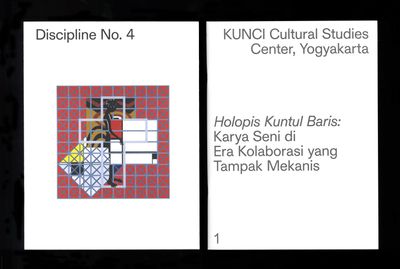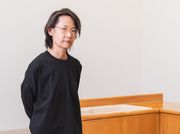Circulate and circuit break: curatorial reflections on TarraWarra Biennial 2016 'Endless Circulation'
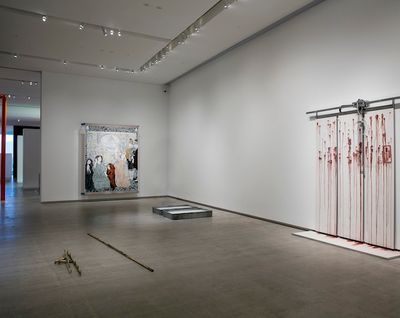
Installation view, Endless Circulation, TarraWarra Biennial, TarraWarra Museum of Art (19 August–6 November 2016). Photo: Andrew Curtis.
The principles that motivate and structure periodic exhibitions (such as biennials) and contemporary art journals have become increasingly intertwined. To begin with, biennials and journals operate within an international context that includes numerous periodical, temporary exhibitions of contemporary art that occur worldwide, with 175 large-scale periodic exhibitions and counting, from the Biennale of Sydney to the Tbilisi Triennial. 1 Similarities between the periodic exhibition and journal format include attempts at defining and mapping the contours of contemporary art, with shared structural frameworks playing host to guest artists, writers, editors and curators.
More recently, we have seen collaborations between the two formats take place. For the 56th Venice Biennale in 2015, for example, e-flux journal's 'Supercommunity' project regularly emailed a curated programme of essays related to the Biennale to e-flux's vast subscriber base. Here, the journal became the bond in a montage of relations that kept the exhibition's contextual dialogue alive, which included Biennale visitors and those who could not attend. A different model was explored by DIS, the artist and curatorial collective behind the online DIS Magazine, who curated the 9th Berlin Biennale in 2016, The Present in Drag, offering an example of an online journal acting as the curator of a biennial. The show reflected on the art world's immersion in globalisation ('the virtual as the real, nations as brands, people as data, culture as capital, wellness as politics, happiness as GDP'): themes that stemmed from the journal's online perspective.
For the 9th Berlin Biennale, the periodic exhibition and the journal were both presented as implicit in the circulatory flows of trans-national production, even if both formats participate in different modes of circulation and channels of distribution. For instance, where biennials typically bring international artists, artworks and audiences to one place for a designated period of time (a centripetal movement), journals disperse—they move away from their site of origin through postal systems, emails and downloads (a centrifugal movement). But despite such seeming oppositions, the highlighting of this trans-national framework offers a unifying frame through which to consider both formats together.
Simon Sheikh has offered a way to think through the structural framework of magazine culture. He has stated: 'A magazine is never just one issue, one article, or one illustration, but one after the other, in a basic principle of addition, of this one and that one, and so on. A magazine is, in other words, a form of assemblage that can be described as montage.' 2 Moreover, Sheikh suggests that a magazine can be seen as an entity that refreshes our understanding of the image. As Sheikh writes: 'A magazine is a connector as well as a producer, and how it connects one or more points is central to its work, to the connection of its connection.' 3 As per Sheikh's description, one might call the magazine, then, a type of curatorial work—that is, the work of forging new connections.
In describing a magazine as a montage, Sheikh is referencing philosopher Jacques Rancière, who describes a montage as a set of relations that are mobile. 4 Rancière 's notion of 'co-belonging' can be applied to this discussion of periodic exhibitions and journals, for we see the mobilisation of a set of materials (works, text, image) in order to create new assemblages of ideas, relationships, influences and connections. Likewise, biennial-type exhibitions, which aim to make a statement about contemporary art, offer the opportunity for the production of new works, the staging of events, and the commissioning of texts by artists, curators and writers. Both formats create networks of meaningful relationships between heterogeneous objects—they activate the gaps in-between. Crucially, however, where magazines forge relations over distant geographies and times, biennial-type exhibitions forge relations in one place, at one time, and therefore possess a powerful social quality. 5
Although stimulating and significant events in their own right, each with their own local inflections, the expanding phenomenon of biennials and triennials around the world also bears a direct relationship to globalisation. Large-scale periodic exhibitions invariably pivot around the notion of hospitality and networking, inviting arts workers to travel, meet, participate, and exchange within their frameworks. All this international travel—whether for residencies, symposia, exhibition opportunities and art tourism—is made possible by the increasingly inexpensive international travel and instantaneous communication that is synonymous with globalisation. This demand for cheap travel and instant communication, in turn, feeds into the development of globalisation and its ever-more pervasive spread to new parts of the world (such as post-socialist Tbilisi, with its Triennial established recently in 2012). Similarly, like new recursive exhibitions of contemporary art that are sometimes deployed as a force of economic regeneration in a location, periodic journals run the risk of becoming complicit within the forces of global capital.
As such, we find it is increasingly incumbent on such biennial-type exhibitions to find methods to circuit-break or self-reflect on the homogeneous frames surrounding the presentation of contemporary art. While we are unavoidably part of a global system, it is important that the most preeminent circulatory system—transnational capital—is countered with possible escape routes, imaginative forms of resistance, and metaphors of subversion. Like exhibitions, journals and magazines are public sites: both journals and exhibitions are primarily concerned with the acts of making public. It is therefore imperative to find new ways of analysing dominant exhibition and publication models, and developing decentralised spaces therein—sites of riposte, agency and dialogue for and between artists, curators, writers and publics.
It is telling to compare the compounding of art exhibitions and magazines in Conceptual art projects of the 1960s and '70s, where artists collapsed the site of the exhibition into the site of the publication in projects like Dan Graham's Homes for America of 1966 published on the pages of Arts Magazine. Through projects like Homes for America, Graham, along with other Conceptualists, forced the question: what happens when an article becomes an artwork, and a magazine becomes an exhibition? What are the effects of collapsing an exhibition that presents or makes public an artwork, and an art magazine or journal, that—at least traditionally—functions to interpret or historicise artworks, artists, curators and exhibitions? By 1969, Seth Siegelaub—who became the key curator-publisher of exhibitions-as-books—pronounced: 'The catalogue can now act as the primary information for the exhibition, as opposed to secondary information about art in magazines, catalogues, etc. and in some cases the "exhibition" can be the "catalogue". 6
The connections between periodic exhibitions and journals have been charted in different ways over the last decade in particular. In Kassel in 2007, documenta 12 launched a magazine project, directed by curator and editor Georg Schoellhammer. documenta 12 invited over 90 publications—with different formats and topics—from around the world to discuss the leitmotifs of the exhibition. This resulted in three printed editions of the documenta magazine; an online journal where readers could assemble their own magazine; and over 300 articles, interviews, artist pages and commentaries around the topics. The 90 publications were also on display within the exhibition itself. Unfortunately, documenta 12 did not allow the magazines to use the server after the event finished, and the promised global montage of articles from around the world did not continue. (All that remains is a link to a 404 page.)
A decade on, documenta 14, curated by Adam Szymczyk, has worked with the Athens-based journal South as a State of Mind as a textual platform. Founding editor Marina Fokidis inaugurated the magazine in 2012 in order to present diverse perspectives around contemporary art and visual culture from the 'Global South', a concept that is understood by the magazine to be both geographic and metaphorical. Pre-dating this magazine's concept were important precursors, such as the South Project (2003-13), founded by Kevin Murray of Craft Victoria; Empires, Ruins + Networks publication and conference, Melbourne, 2004-05 7; and South, South, South, South: Seventh International Symposium of Contemporary Art Theory in Mexico City, 2009. 8 South as a State of Mind will 'host' documenta 14 until the opening of the exhibition in 2017 in Athens and Kassel, with a documenta 14-installed a team editing the magazine. Of course, this relationship has its challenges in terms of who is the host and who the visitor, and while both documenta 12 and 14 have attempted to forge global dialogues about exhibitions of contemporary art through magazine culture, they have have encountered major limitations along the way.
This brings us to the TarraWarra Museum of Art's 2016 collaboration with the Australian contemporary art journal Discipline to curate the TarraWarra Biennial 2016: Endless Circulation, a collaboration that developed organically throughout 2015 and 2016 concurrent to the 56th Biennale of Venice and the 9th Berlin Biennale. 9 We asked what would happen if a biennial collaborated with a journal; not in the sense of a 'special issue,' a textual platform, or indeed as the curator, per se (as with the Venice, Berlin and documenta models), but rather in order for both platforms to hold a mirror up to the other and look more closely at the critical and institutional practices embedded in each. This edition of the Biennial was presented as an intertwined platform, with an exhibition, performances, talks, a lecture series, and a dedicated issue of Discipline, which acts as a record of the lectures presented by various writers during the exhibition in response the theme of 'endless circulation'. Together, we explored themes of continuity and circulation through specifically colonial and decolonial lenses in contemporary Australian art. Vincent Namatjira looked at the continuity of white, and predominantly male, Australian Prime Ministers over the course of his lifetime, while Ryan Presley imagined a monetary currency emblazoned with the faces of important Aboriginal activists, like Pemulwuy and Noonocul, that he set into circulation. Conjuring memory—of materials, cultures, language and land—was another distinct concern, with Bianca Hester walked the route of an ancient lava flow in Aotearoa New Zealand and collaborated with geologists and Maori elders alike to learn the significance of the site throughout its long and variegated history.
In addition, several artworks focused viewers' attention on the circulation of their own bodies through the gallery's spaces, with Wrong Solo taking guided 'cruises' through the gallery, stopping in front of artworks to do back-rolls and take deep breaths. Others pointed to the circulation of non-human air and water-borne matter through the gallery's air conditioning and plumbing systems: Debris Facility created a special soap that was washed down the drain when visitors used it in the bathroom. Many artists also considered the preeminent circulatory system—that of transnational capitalism—and in so doing figured possible escape routes and imagined forms of resistance. Newel Harry, for example, presented a documentary photography installation about the Kula trading ring in Papua New Guinea, which involves a tradition of ceremonial exchange between communities.
In these ways and more, Endless Circulation attempted to map temporary escape routes out of trans-national capitalism, and find new ways of looking at, being in, and thinking about platforms of contemporary art as modes of belonging and exchange. There has been a subtle and complex history of entanglements between biennials and journals. Their mutual support of each other, even when they disagree, is a sign that like-minded collaborative initiatives can create a broad reaching impact in the context of increasingly conventional exhibition and publishing modalities. —[O]
Victoria Lynn is Director of TarraWarra Museum of Art, Healesville, Victoria, AustraliaHelen Hughes is co-founder and co-editor of Discipline, and Research Curator at Monash University Museum of Art.
—
1 Osborne, P. (2015) 'Every Other Year Is Always This Year: Contemporaneity and the Biennial Form', in Making Biennials in Contemporary Times, São Paulo, Biennial Foundation, Fundação Bienal de São Paulo, ICCo - Instituto de Cultura Contemporânea, p. 23.
2 Simon Sheikh, (Feb 2015) 'Circulation and Withdrawal Part I: Circulation', e-flux Journal #62 http://www.e-flux.com/journal/62/60945/circulation- and-withdrawal- part-i- circulation/ accessed 3 December 2016.
3 Ibid.
4 Rancière, J. (2007). The future of the image. London, Verso.
5 Documenta 14 is an exception to this being located in both Kassel and Athens.
6 Siegelaub, S. (Dec. 1969), 'On exhibitions and the world at large', interview with Charles Harrison, Studio International
7 McQuire, S. and Papastergiadis, N. (2005) (ed's), Empires, ruins + networks: the transcultural agenda in art, Melbourne University Press.
8 Medina, C. (2010) South, South, South, SITAC, Mexico.
9 A collaboration between TarraWarra Museum of Art's Victoria Lynn and co-founder of Discipline, Helen Hughes.

